Understanding the role of protein in our diet and its impact on overall well-being is fundamental knowledge for many. Proteins are essential for cell repair, the creation of healthy cells, and play a vital role in growth and development, particularly during critical life stages like adolescence and pregnancy.
However, what may come as a revelation to some is that human hair largely consists of protein and requires it to flourish. Among the essential proteins contributing to hair health, keratin stands out as a core element that bestows strength, softness, and vitality. Yet, our daily hair routines, whether involving heat styling, coloring, or exposure to harsh chemicals, often take a toll on our locks. This is where protein treatments come to the rescue.
Board-certified dermatologist, Dr. Robert Finney, explains the importance of protein treatments in this context, stating that they aid in repairing damaged bonds within the hair and infuse essential amino acids and proteins to restore strength and mend hair damage.
In the pursuit of a comprehensive understanding of protein treatments – their mechanisms, application, and advantages – we consulted several experts to shed light on the subject. Read on to have all your questions about protein treatments addressed, and discover some of the top professional-recommended products available in the market today.
Understanding Protein Hair Treatments
A protein treatment, as its name implies, is a targeted solution for hair care formulated with proteins to rehabilitate damaged tresses. Dr. Finney elucidates that factors such as hair dye, heat styling, and chemical treatments can wreak havoc on the hair’s cuticle, the underlying shaft, and the bonds responsible for its resilience. This, in turn, leads to dryness, brittleness, and issues like increased breakage and frizz.
Certified trichologist, Shaniqua Garcia, elaborates that protein treatments are tailored to fortify the outermost layer of the hair cuticle by introducing proteins and amino acids. This two-fold approach, she adds, not only replenishes essential moisture but also shields strands from further harm.
Benefits of Protein Treatments for Hair
If you battle with dry, frizzy hair prone to breakage and split ends, incorporating a protein treatment into your haircare routine can be a game-changer.
Garcia recommends protein treatments for those with high porosity hair, individuals who’ve undergone chemical treatments, or those facing the issue of limp, easily breakable hair. The advantages are manifold, encompassing reduced frizz, enhanced moisture retention, restoration of elasticity or “bounce,” and the addition of shine.
Moreover, since protein treatments are engineered to fortify hair, they can help curb breakage and proactively protect against future damage. This proves particularly beneficial for those grappling with hair loss stemming from breakage.
In essence, protein treatments offer a plethora of benefits and hold the potential to elevate overall hair quality, provided they are used correctly.
The Delicate Balance Between Protein and Moisture
Protein treatments are potent and should be used sparingly, typically every four to six weeks. Overuse, or employing them when unnecessary, can render hair stiff and prone to breakage, warns New York City-based hairstylist Mahogany Grace. Therefore, it is crucial to discern whether your hair truly requires additional protein or if it’s in need of conditioning or deep conditioning.
Grace clarifies the distinction: “Your hair craves protein when it appears limp, lacks its usual curl or wave due to low elasticity, and exhibits excessive frizz.” Conversely, if your hair appears dry, lacks luster, feels brittle, straw-like, and tangles easily, these are indicators of a moisture deficiency.
Keep in mind that protein and moisture are interconnected. Adequate protein levels contribute to moisture retention. Thus, following a protein treatment, it is advisable to apply a deep conditioner to strike the right balance.
In conclusion, mastering protein treatments involves understanding when and how to use them judiciously, as well as recognizing the delicate equilibrium between protein and moisture crucial for maintaining hair health and vitality.


